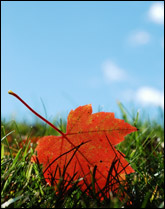Send your question to Umbra!
Editor’s Note: Our dear Umbra Fisk is wrapping up her well deserved vacation. In her absence, we’re springing some archival columns from the vault. Since summer’s fading and fall is coming on fast, we thought we’d peep in on the topic of autumn leaves. Yeah, we’re fun-stoppers like that.
Q. Dear Umbra,
With fall here, the leaves are changing and falling from the trees. What is the best way to handle them? Burning them makes so much smoke, but putting them in trash bags and sending them to the landfill doesn’t seem like a good thing to do either. Please advise. Thanks!
Molly R.
South Bend, Ind.
A. Dearest Molly,
Keep them. Partially decomposed deciduous leaves are an excellent source of micronutrients. In fact, they are generally considered the world’s best mulch, with a special name: leaf mold. If you don’t believe me, ask some local gardeners. They will think you are insane to get rid of your leaves.

Fall guy.
So, what to do with them? Well, your trees will appreciate being mulched with their own leaves for the winter, and the rest of your garden plants won’t complain either. You can rake piles of whole leaves around trunks and bases, or run the mower first to chop them into smaller pieces. (Chopping serves two purposes: the leaves will decompose more quickly, and the wind will blow them about less easily.) Plants of all sizes can use two to three inches of mulch; just leave a couple of inches of open space around the base for air circulation. In the early spring, you’ll see that the leaves on the bottom have decayed into succulent crumbs.
Or you could start a leaf-mold factory: find a place in your yard to pile all your deciduous leaves, soak them with water, and let them be for a couple of years. Maybe you want to make a wooden box for them, or put them in a commercial compost bin — whatever works with your yard’s aesthetic. Just leave the leaves (ha ha) and come back to find a pile of humus that would cost you an arm and a leg anywhere else. Leaf mold, as a mulch, is somewhat beyond compare — it is stable and has excellent moisture retention. Beneficial fungi play a major role in leaf decomposition, and although we puny humans currently have a limited understanding of the role of fungi in plant life, it is clear that a fungi-rich soil is excellent for most garden plants and trees. Here, the extra rotting time allows the leaves to decompose more completely and become more biologically stable than the insta-mulch option, so I prefer this route.
If you cannot see your way to keeping your leaves, ask community gardens, schools, or composting businesses if they would like them. I assume from your note that there is no yard-waste curbside service in South Bend, but other of my dear readers might have this option. Wherever you are, don’t let any gardening fanatics see you getting rid of leaves. They’ll have you institutionalized.
Autumnally,
Umbra



